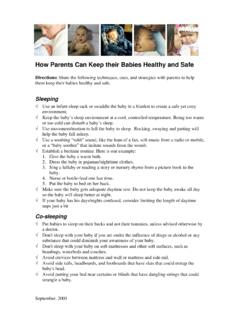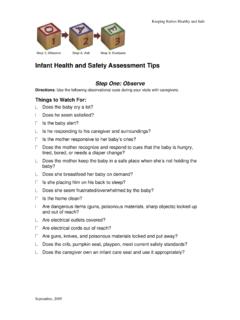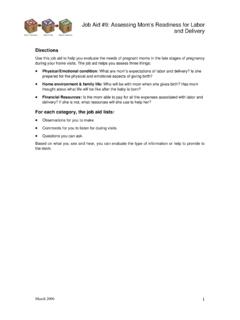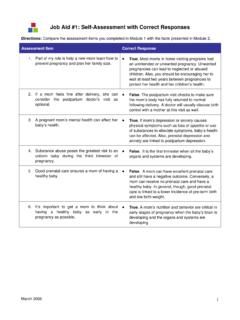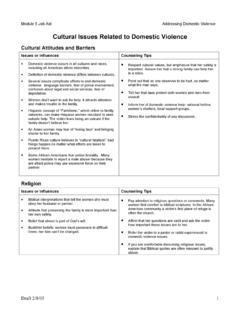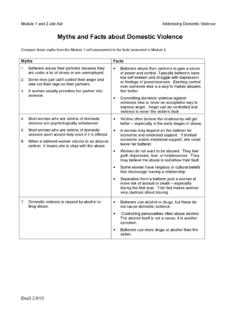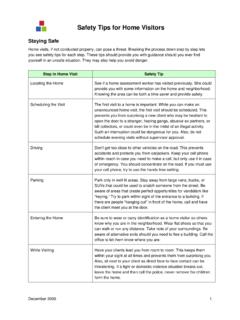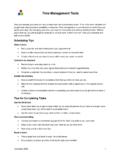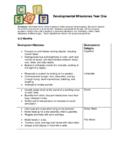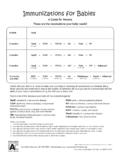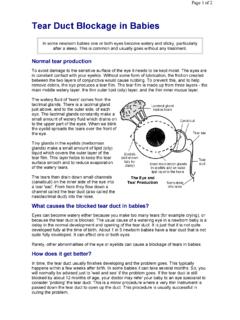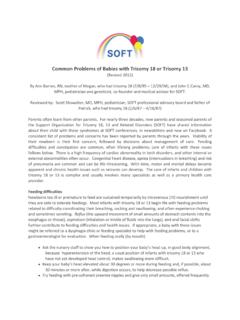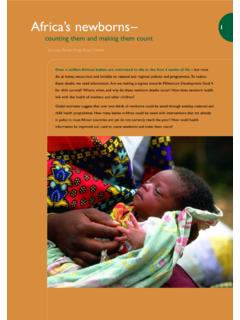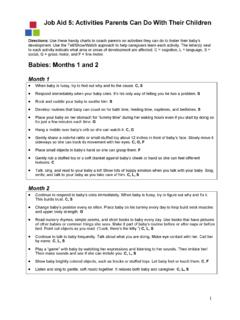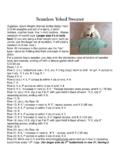Transcription of Activities Parents Can Do With Their Babies- …
1 August, 2005 1 Activities Parents Can Do with Their babies - MONTHS 1 and 2 Directions: Use these handy charts to coach Parents on Activities they can do to foster Their baby s development. Use the Tell/Show/Watch approach to help caregivers learn each activity. The letter(s) next to each activity indicate what area or areas of development are affected. C = cognitive, L = language, S = social, G = gross motor, and F = fine motor. Month 1 When baby is fussy, try to find out why and fix the cause. C, S Respond immediately when your baby cries. It s his only way of telling you he has a problem. S Rock and cuddle your baby to soothe him. S Develop routines that baby can count on for bath-time, feeding time, naptimes, and bedtimes. S Place your baby on her stomach for tummy time during her waking hours even if you start by doing so for just a few minutes each time.
2 G Hang a mobile over baby s crib so she can watch it. C, G Gently shake a colorful rattle or small stuff toy about 12 inches in front of baby s face. Slowly move it sideways so she can track its movement with her eyes. C, G, F Place small objects in baby s hand so she can grasp them. F Gently rub a stuffed toy or a soft blanket against baby s cheek or hand so she can feel different textures. C Talk, sing, and read to your baby a lot! Show lots of happy emotion when you talk with your baby. Sing, smile, and talk to your baby as you take care of him. C, L, S Month 2 Continue to respond to baby s cries immediately. When baby is fussy, try to figure out why and fix it. This builds trust. C, S Change baby s position every so often. Place baby on his tummy every day to help build neck muscles and upper body strength.
3 G Read nursery rhymes, simple poems, and short books to baby every day. Use books that have pictures of other babies or common things she sees. Make it part of baby s routine before or after naps, or before bed. Point out objects as you read. ( Look, there s the kitty. ) C, L, S Continue to talk to baby frequently. Talk about what you are doing. Make eye contact with her. Call her by name. C, L, S Play a game with baby by watching her expressions and listening to her sounds. Then imitate her! Then make sounds and see if she can imitate you. C, L, S Show baby brightly colored objects such as blocks or stuffed toys. Let baby feel / touch them. C, F Listen and sing to gentle, soft music together. It relaxes both baby and caregiver. C, L, S August, 2005 2 Activities Caregivers Can Do with Their babies MONTHS 3 and 4 Month 3 Cuddle and hold baby.
4 S Play talking back and forth with baby. Baby makes a sound and caregiver repeats it. Caregiver then makes the sound for baby to repeat. This can go on many times. C, L, S Place baby onto back and let her reach for toys hanging from side of crib or playpen. C, G, F. Place baby on tummy (every day!) and let her reach for toys placed just at the edge of her reach. Show her how to reach for the objects. G, F Play peek-a-boo using hands or a blanket. C, L, S Continue talking with baby and reading to baby a lot! Point out and name objects in books or objects baby touches. Your blanket is soft. Feel the soft blanket. )Make sounds to imitate animals you re reading about. C, L, S If weather permits, take baby outside. Let her watch birds flying, leaves fluttering, and the shifts of light and shadow.
5 Identify sounds baby can hear ( Hear the leaves in the trees. Listen to the airplane. ) C, L, S Hold a rattle and move it slowly from side to side. Encourage baby to track the rattle with her eyes. Let her grasp rattle, shake it, and mouth it. C, G, F Show baby how to roll by placing hands under her shoulders when she s on her back. Gently rock baby back and forth, talking to her while rocking her. L, S, G Month 4 Cuddle and hold baby. S Let baby sit propped up on pillows even if she can only do it for short periods at first! G Lay baby on tummy or back. Place toys just beyond his reach to encourage him to wiggle and reach for the toy. Place toy in his grasp if he isn t able to get it after a few seconds of trying. G, F. As needed, continue to encourage baby to roll over. Spread a baby blanket and lay baby on her stomach at one edge.
6 Gently lift the blanket so she will roll onto her back. Praise her and reward her with a hug and kiss. L, S, G Prop an unbreakable mirror up next to baby as he lies in front of it. Let him look at himself. Point out his eyes, nose, mouth. Lay next to him and smile into the mirror. C, L, S Take baby different places such as the library, the store, and the park. Let him see and hear different things. Talk to him about what you are seeing and doing. C, L, S Make sure baby has toys to play with , hold, and place in his mouth. This is how babies learn about Their world, C, G, F Continue to play talking back and forth with baby, imitating her sounds and encouraging her to repeat sounds you make. C, L, S August, 2005 3 Activities Caregivers Can Do with Their babies MONTHS 5 and 6 Month 5 Continue to cuddle and hold baby.
7 Keep routines going for feeding, bathing, naptime, and bedtime. Cuddle baby before naps and bedtime and during feeding times. S Talk to baby. Talk about the toys baby is playing with . Show baby how to use the toys. Use complete sentences. C, L, F, G Hide toys under a blanket ( with baby watching toy being hid). Encourage baby to look for toy. C, L. Place favorite toys just beyond reach to encourage baby to wiggle toward toy or reach for toy. C, L, G, F Make sure baby has plenty of time to play on the floor to strengthen muscles as he rolls, wiggles, and reaches for things. G Hold baby in front of the mirror. Point out baby and caregiver in the mirror. C, S Hand baby a toy. After placing the toy in one hand, move it to the other. Baby will learn to transfer the toy from hand-to-hand.
8 C, F Help baby stand by holding her under her armpits. G Read short stories to baby. Sing songs, and recite rhymes about his eyes, nose, and mouth. C, L, S Continue letting baby sit up propped by pillows. Place toys just beyond reach to encourage movement. G, F Month 6 Let baby play with pots and pans from the kitchen. Give her lids to fit onto pots and smaller pots to fit within bigger pots. C, G, F Make sure baby gets lots of time on the floor so she can learn to creep and crawl. Play on the floor with her. S, G Continue to help baby stand by holding her under her armpits and letting her feet touch the floor. G Prop baby into a sitting position. Roll a soft ball toward her. Clap and praise her when she rolls it back to you. L, S, G, F Give baby two plastic cups or large spoons.
9 Show her how to bang them together or on the floor. C, G, F Play naming games with baby. Point to her nose and say nose. Do the same thing with her eyes, mouth, ears, and toys. C, L, S Place several empty plastic cups, spoons, or other safe objects into a shoe box. While baby watches, take them out one-by-one. Then put them back. Baby will eventually imitate you. C, G, F Play pat-a-cake, teensy-weensy spider, or piggy with baby. C, L, S Read, read, and read. Make sure reading is part of every day. Re-read favorite books over and over. Get new books from the library. C, L, S August, 2005 4 Activities Caregivers Can Do with Their babies MONTHS 7 and 8 Month 7 Continue offering lots of floor time to baby. Create a safe cabinet in the kitchen that contains items she can play with plastic cups, pots, lids, etc.
10 Encourage her to remove things from the cupboard and put them all back. C, G, F Continue to help baby stand by holding her under her armpits and letting her feet touch the floor. G Help baby sit. Allow her to try sitting without propping. Place pillows around her to cushion falls. G Give baby two plastic cups or large spoons. Show her how to bang them together or on the floor. C, G, F Play naming games with baby. Point to her nose and say nose. Do the same thing with her eyes, mouth, ears, and toys. C, L, S Place several empty plastic cups, spoons, or other safe objects into a shoebox. While baby watches, take them out one-by-one. Then put them back. Baby will eventually imitate you. C, G, F Play pat-a-cake, teensy-weensy spider, or piggy with baby. C, L, S Read, read, and read.
